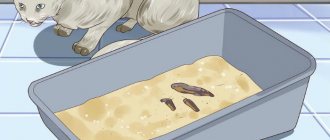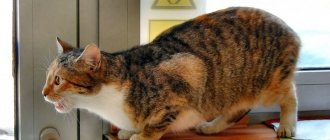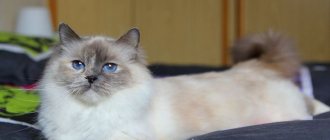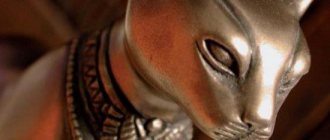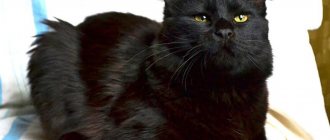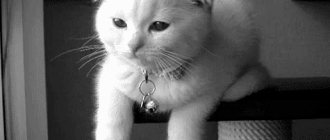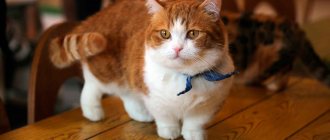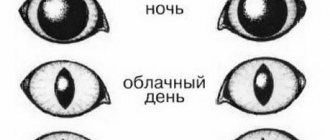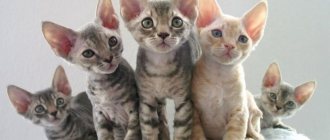Cats... Many people's pets. Some people like red ones, some like black ones, some like mosaic ones. Others are attracted to Persians, Siamese cats or Egyptian cats. It's all a matter of taste.
However, the color of an animal, its exterior, character, diseases, pathologies, mutations depend not only on the breed or lifestyle, but also on the chromosome set (primarily on it), which is constant and definite.
And yet, how many chromosomes does a cat have, what are their numbers and functions? This will be discussed below.
Genome and chromosomes
It is extremely difficult to talk about how many chromosomes a cat has without basic knowledge of genetics.
A genome is a structure that contains the genetic information of an organism. Almost every cell contains a genome. But the chromosome contains all the information about the structure of the cell. A chromosome is a nucleoprotein structure in the nucleus of a eukaryotic cell. The chromosome contains a significant part of hereditary information, which is stored, implemented and transmitted to the future generation.
A chromosome is a structure in the cell nucleus made up of deoxyribonucleic acid (DNA) and proteins. It is worth recalling that DNA is a macromolecule that ensures storage, transmission from generation to generation, and the implementation of the genetic program for the development of a living organism.
There are two types of chromosomes in different organisms:
Eukaryotic type - characteristic of living organisms (eukaryotes), whose cells contain a nuclear membrane, DNA molecules in the nucleus and mitochondria.
Prokaryotic type - found in organisms whose cells lack a nuclear envelope, and DNA molecules are enclosed in histones (prokaryotes).
Externally, a chromosome looks like a long thread with stringed beads, each of which is a gene. In addition, the gene is located on its strictly fixed part of the chromosome - the locus.
Hereditary factors
The karyotype plays a determining role in the heredity of cats. The somatic cell of an animal contains 38 chromosomes, which, in turn, consist of smaller particles - DNA genes. These genes carry information that will certainly be passed on to subsequent generations, with the exception of cases where we are talking about a castrated individual. Any external manifestations in a kitten that are characteristic of its parents are called a phenotype.
Since the number of chromosomes (with the exception of the sex chromosome) is paired, this means that information is transmitted from both the mother and the father. However, the amount of information inherited may vary. It depends on which gene expresses itself to a greater extent.
It is known that they can be dominant and recessive. There is a significant difference here:
| Dominant | Recessive |
| It is the leader, and accordingly, the information stored in it appears in the first generation of the inheritance. Indicated in capital Latin letters | It is not as strong as the dominant one, and therefore, as a rule, manifests itself only in subsequent generations, for example, in the second or even third. Indicated in lowercase Latin letters. |
Depending on the combination of genes, homozygous and heterozygous types are determined. The first is AA or aa, that is, a combination of two dominant or two recessive genes. The second is Aa, a combination of dominant and recessive genes. The stronger gene actively manifests itself in any variant of the combination, but the weaker one - only in homozygous aa.
It is noteworthy that if cats give birth to a kitten with the homozygous type aa, then it may be completely different from its parents, since weak genetics will manifest itself only in its descendants. That is, for example, his “grandchildren” will look like the cat’s parents.
It is the chromosomes that transmit by inheritance such important information as:
- coat color and type;
- eye color;
- tail length and thickness;
- size and location of the ears, shape of the auricle;
- predisposition to certain diseases.
Coat color
Among the set of genes in cats, there are those that are directly responsible for the color of the coat and its structure. This scheme works like this: a non-reproductive somatic cell contains a certain number of such genes. Their task is to inhibit the spread of melanoblasts. This is a pigment that, in fact, gives the coat a particular color. If the gene prevents melanoblasts from reaching the hair, then the hair in this place does not color and remains white. If this gene is not present in certain cells, it means that migration of melanoblasts is possible here, as a result of which the coat color occurs. This is how characteristic spots appear on the animal’s body.
Among the set of genes in cats there are those that are directly responsible for coat color and its structure.
The normal pigment, which is not influenced by genetic information, gives the striped color. But genes can cause melanoblasts to color their fur in different shades. It all depends on the karyotype. Heterozygous cats will have a striped color, while homozygous cats will have a uniform color.
Sometimes a gene mutation is possible, as a result of which the production of the tyrosinase enzyme decreases or even stops. As a result, the animal develops albinism.
Mosaic
When a kitten has one or two colors, this is a normal phenomenon, familiar to everyone. But sometimes a pet can look like a real mosaic, because its fur combines three or even more shades. Why is this happening?
Naturally, it’s all about the genes that make up these structures. The genes responsible for coloring are contained on the X chromosome. The reason for the mosaic pattern is that the chromosome consists of various genes that “color” the coat. That is, there is nothing extraordinary here, although it is a comparative rarity.
Sometimes a pet can look like a real mosaic, because its fur combines three or even more shades
Number of chromosomes in animals
How many chromosomes are there in cat cells? Any living organism has homologous or paired chromosomes and haploid or unpaired (sex) chromosomes. The latter include the egg and sperm; they have a set of XX and XY, respectively. When dividing, they break up into X, X and X, Y. Depending on the new combination of the pair in the fertilized cell, the sex of the new organism (in our case, a kitten) will be determined.
To the question: “How many chromosomes are there in cat cells?”, genetics gives an exact answer. In a domestic cat, the chromosome set includes 19 pairs of chromosomes (18 paired and 1 unpaired: XX in females and XY in males). The total number of chromosomes in a cat is 38.
In other animals, the number of chromosomes is constant and individual for each species (for example, dogs have 78 chromosomes, horses have 64, cows have 60, and hare has 48). Recall that humans have 46 chromosomes.
Brain and endocrine system
Anatomically, a cat's brain is similar to the brain of any mammal.
The structure of a cat's brain is similar to that of any mammal.
Different parts of the brain are responsible for one or another function in the body:
- the parietal lobe processes information received through the senses;
- the large brain is responsible for consciousness;
- the corpus callosum connects the right and left hemispheres;
- the frontal lobe is responsible for voluntary movements;
- the olfactory bulb is responsible for the perception of smells;
- the hypothalamus secretes hormones and controls the autonomic nervous system;
- the pituitary gland coordinates and controls the work of other glands;
- the spinal cord transmits information from the brain to the body;
- the pineal gland is responsible for sleep and wakefulness;
- the cerebellum controls movements and muscle function;
- the temporal lobe is responsible for behavior and memory;
- The occipital lobe receives visual and tactile signals.
The endocrine system influences the basic functions that occur in the body with the help of hormones. Most hormones are secreted by the pituitary gland and hypothalamus. Also some of them are produced by the thyroid gland, adrenal glands, ovaries in cats and testicles in cats.
The endocrine system influences the body's basic functions
Table: hormonal regulation of cat body functions
| Hormone name | Where is it produced? | Functions |
| Antidiuretic hormone (ADH) | Hypothalamus | Urine concentration |
| Oxytocin | Hypothalamus | Labor and feeding of kittens |
| Corticoliberin | Hypothalamus | Adrenocorticotropic hormone concentration |
| Adrenocorticotropic hormone (ACTH) | Hypothalamus | The adrenal glands produce cortisol when the cat is afraid |
| Thyroid-stimulating hormone (TSH) | Pituitary | Thyroid activity |
| Melanocyte-stimulating hormone (MSH) | Pituitary | Melatonin synthesis in the pineal gland |
| Follicle stimulating hormone (FSH) | Pituitary | Production of sex hormones and eggs in females |
| Luteinizing hormone (LH) | Pituitary | Production of sex hormones and sperm in males |
| Adrenalin | Adrenal glands | Cardiac activity and dilation of blood vessels |
| Progesterone | Ovaries | Preparing the uterus for implantation of embryos, maintaining pregnancy, stimulating the development of mammary glands |
| Testosterone | Testicles, adrenal glands | Development of the cat's reproductive system, development of secondary sexual characteristics |
| Thyroxine | Thyroid | Activation of metabolism, thickening of the uterine walls, increase in heart rate |
Karyotype and chromosome complex of a cat
A karyotype is a paired set of chromosomes with a specific number, size and shape for each animal species. The characteristics of each type of living organism are inherited by karyotype. For example, a karyotypic feature may be the presence of a trunk in elephants. The birth of a baby elephant without a trunk will be a deviation from the karyotypic norm, that is, a pathology.
All cells are paired, the future appearance, appearance, color, and character of the cat depend on them. The last - 19 pair contains sexual information and half of the chromosome set. During the process of fertilization, both parts join together to form a complete cell.
Heredity of cats
There are 38 chromosomes in a cat's somatic cell, which contain DNA molecules with genotypic information. Genotypic manifestations that are reflected in the external appearance of a living organism are called phenotype. Phenotypic manifestations of kittens vary in color and size of the animal.
The offspring have paired genes - one gene from the female, and the other from the male. As you know, genes are divided into dominant (strong) and recessive (weak). Dominant genes are indicated in uppercase, Latin letters, recessive - in lowercase. Depending on their combination, homozygous (AA or aa) and heterozygous (Aa) types are distinguished. The dominant gene manifests itself in both homo- and heterozygous states. The recessive gene will manifest its characteristics only in the homozygous type (aa). This genetic knowledge is useful in calculating the traits of future kittens from the phenotypic expressions of their parents. Here it is important to know which gene responsible for the manifestation of a certain trait is recessive or dominant.
Animal color genes are located on the X chromosome, they are presented in the table below:
| a | Grey |
| b | Chocolate |
| c | Platinum, lilac |
| d | Ginger |
| e | Cream |
| f | Tortoiseshell |
| g | Tortoise blue cream |
| h | Turtle chocolate |
| j | Tortoiseshell lilac |
| n | Black |
| o | Sorel, honey |
| p | Yellow-brown |
| q | Tortoiseshell red-brown |
| r | Tortoiseshell tan |
| s | Smoky |
| w | White |
| y | Gold |
| x | Unregistered color |
Breeding wide-footed cats
Broad-footed Maine Coon breeds are bred in nurseries based on breeding programs, where the corresponding gene is passed on between generations. To produce offspring with polydactyly, one parent must have a foot anomaly - then the birth of offspring with polydactyly is possible with a probability of 56% (not all kittens in the litter are polydactylic).
If you breed two wide-legged animals, the likelihood of having polydact kittens increases by another 20%. Mating, where one parent is a homozygous polydact, leads to the fact that the entire litter will be polydactyl.
Polydactyly in cats
The polydactyly gene behaves unpredictably. It is expressed differently in offspring, regardless of the combination of fingers of the parents. In contrast to other dominant genes, it manifests itself in different ways in both homo- and heterozygous forms.
Breeders of broad-toed cats continue to conduct statistical work, trying to discover more accurate information about the likelihood of producing multi-toed kitten offspring.
Be sure to read:
Caring for an amazing raccoon cat - Maine Coon
Coat color
In a thousand genes of cats there are those that are responsible both for their coloring and for the mutation that leads to a change in the color and structure of the coat. A non-reproductive somatic cell contains in the proto-oncogene elements of a mutation in coat color, which inhibits the migration of melanoblasts. Therefore, the latter cannot penetrate the skin, and the pigment, accordingly, does not reach the hair of the coat. This explains the white coat of the animal.
Some melanoblasts manage to get into the hair follicles on the cat's head, and then colored spots appear on the fur. These cells may well reach the retina of the eyes: with a small number of melanoblasts, the eyes become blue, and with a large number, the animal’s pupils will be yellow.
The same chromosome is also responsible for coat color. The usual structural form of melanoblasts gives the animal a striped color. There are also semi-dominant changes, for example, in the Abyssinian tabi. Homozygous individuals do not have stripes, the color is uniform, and heterozygous individuals with this mutation are distinguished by stripes on the muzzle, paws, and tail. In the case of a recessive change, the transverse stripes on the animal’s fur are deformed into irregular lines on its back, appearing in powerful longitudinal stripes of black color.
A gene mutation affecting the enzyme tyrosinase leads to albinism. This occurs not only in cats, but also in other mammals.
Tyrosinase reduces its activity depending on the temperature of the cats - the lower it is, the more active the enzyme. In such cases, there is intense staining of the peripheral parts of the body: the nose, tips of the paws and tail, and ears in Burmese cats.
What heritable traits are transmitted by chromosomes?
Genetics is a baby in the scientific world. It is the same cosmos, only inside an individual. To date, scientists have been able to isolate a negligible number of genes responsible only for the simplest traits:
- wool (its color, structure and length);
- shape and location of the ears;
- eye color;
- body anatomy (tail, paws, height).
Diseases are also inherited. They are called genetic. Here are just a few of them:
- cardiomyopathy;
- Hypertrophic cardiomyopathy is a hereditary disease manifested in thickening of the walls of the ventricles of the heart, which leads to a decrease in their ability to contract porphyria - a disorder of hemoglobin synthesis;
- meningocele - brain herniation;
- von Willebrand disease - increased bleeding of the mucous membranes;
- retinal atrophy;
- polycystic kidney disease.
Mosaic of cats
The set of cat chromosomes responsible for coloring is localized on the X chromosome. Patterned cats are not uncommon, but there are still fewer three-colored cats than two-colored ones.
In this case, the color is determined by the alleles of the O gene:
O - affects the yellow (or red) color of the fur;
o - responsible for black color.
Tortoiseshell cats are heterozygous for this gene, their genotype is Oo.
Their yellow and black spots develop as a result of random inactivation in early embryogenesis of the X chromosome by the O or o allele. Cats can only be homozygous for this trait (OU - red or OU - black).
Tortoiseshell cats are extremely rare - they are characterized by the chromosomal constitution of XXXY and the genotype OoU. This is the reason for the rare birth rate of mosaic cats (or tortoiseshell cats).
Inheritance of the tricolor color of cats:
Color black – XB gene – genotype – XB XB; HVU;
Red color – Xb gene – genotype – Xb xb; HYU;
Tortoiseshell color – gene – XB; Xb – genotype XB; XH.
White color of cats
White color at the chromosomal level is the absence of pigment. Pigment cells are blocked by one gene - W. If the genotype of cats contains recessive traits of this gene (ww), then the offspring will be colored, and if there is a dominant trait (WW, Ww) and at the same time in the genome of cats there will be many other designations of gene chromosomes (BOoSsddWw ), then we will still see a completely white cat. However, such cats can carry both spotting and patterning, but only if the offspring do not inherit the W gene.
Chromosomes of a cat with Down syndrome
This disease occurs not only in humans, but also in animals, cats are no exception.
There are many stories and photographs from the lives of such animals on the Internet. Just like people, such animals can live and be active, but visually they differ from healthy ones. Like people, such animals need certain care, care and treatment.
To the question: “How many chromosomes does a Down cat have?”, one can definitely answer: 39.
Down syndrome occurs when another extra chromosome appears in the gene set of chromosome molecules - an odd one. In the case of cats, this is chromosome 39.
A cat with an extra chromosome is rare in nature for the simple reason that the animal does not use drugs, alcohol, or smoke, i.e. the provoking causes of gene mutation are excluded. But still, this is a living organism, sometimes it also has malfunctions.
Scientists and biologists do not have a definite opinion about the extra chromosome. Some say that this cannot happen, others say that it can, and still others claim that this occurs when an animal is artificially bred as an experimental animal.
A cat with 20 chromosomes (the twentieth pair of chromosomes is an extra one) can be found, but it has virtually no chance of reproducing healthy offspring. This, of course, does not mean that such an animal cannot be loved. They are quite cute, but a little unusual, different, but still they are alive. For example, a cat with this syndrome (Maya from America) became the favorite of her owners (Harrison and Lauren). They created their own page on Instagram for the cat and regularly post photos and videos of it. Maya has become a favorite of Internet users; she is quite active and cheerful, although she suffers from shortness of breath and constantly sneezes. But no one bothers her to live for her own pleasure and for the pleasure of her masters.
By the way, you should not confuse a cat's Down syndrome with genetic mutations that lead to physical changes (deformations) in the animal's faces. This occurs in nature more often than Down's disease, and is caused by crossing between cats-relatives (interbreeding). If there are many animals of the same kind in the offspring, then sooner or later physiological changes will occur not only in the appearance of the animals, but will also affect their development as a whole. While breeders can control this, the owners of cats running around their yards are practically unable to track it. Some people abort such offspring, others, on the contrary, take this philosophically and also love their pets.
KLEINFELTER'S SYNDROME
- Karyotype 47,XXY, sex chromatin test is positive. Y-chromatin is positive.
- The frequency of occurrence is 1:500 – 1:700 newborn boys.
The phenotype is male, gynecomastia is possible, eunuchoid body type (the width of the pelvis is usually greater than the width of the shoulders, elongated lower limbs, tall stature, scanty hair growth), usually microorchidism with a normal penis size. Possible cryptorchidism. In rare cases (with an increase in the number of X chromosomes: 48,ХХХY and 49,ХХХY) – impairment of intelligence and functions of internal organs.
In 5-10% of cases, a mosaic form is observed (46.XY/47.XXY or 46.XX/47.XXY). In rare cases, it is possible to detect spermatogenesis in such patients (if the spermatogenesis cells belong to a clone with a normal karyotype).
Almost all adult patients with Klinefelter syndrome are infertile due to azoospermia.
Considering that most people with Klinefelter syndrome have a male phenotype, normal intelligence, and a sufficient level of potency, they marry. Thus, the indication for testing for sex chromatin is oligoazoospermia in the patient.
How many lives does a cat have?
Everyone knows that in 1996 the first cloning was carried out in the world (the famous Dolly the sheep). Five years later, scientists cloned a cat and gave it a name – Kopirka (in Russian) or Carbon Copy (in Latin).
For cloning, a gray-red tortoiseshell cat, Rainbow, was taken. Eggs and somatic cells were extracted from Rainbow's ovaries. Nuclei were removed from all eggs and replaced with nuclei isolated from somatic cells. Electroshock stimulation was then performed and the reconstructed eggs were transplanted into the uterus of a gray tabby cat. It was this surrogate mother who gave birth to Copier.
But Kopirka had no red spots. The study revealed the following: in the genome of a cat (female) there are two X chromosomes, which are responsible specifically for the color of the animal.
In a fertilized cell (zygote), both X chromosomes are active. During the process of cell division and further differentiation in all cells of the body, including future pigment cells, one of the X chromosomes is inactivated (that is, the cell’s activity is lost or greatly reduced). If a cat is heterozygous (for example, Oo) for the color gene, then in some cells the chromosome carrying the red color allele can be inactivated, in others - the chromosome carrying the black color allele. Daughter cells strictly inherit the state of the X chromosome. As a result of this process, the tortoiseshell coloration is formed.
When a cat was cloned in the nucleus of a reconstructed egg extracted from an ordinary somatic cell of a calico cat, complete reactivation (restoration of viability or activity) of the switched off X chromosome did not occur.
Complete reprogramming of the chromosome nucleus does not occur when cloning a living organism (in this case, a cat). It is likely that this is why cloned animals get sick and cannot always produce healthy offspring. The carbon copy is still alive. She became the mother of three adorable kittens.
Sense organs
With the help of its senses, a cat interacts with the world around it: smells, touches, tastes.
Vision
Cats have the largest eyes among domestic animals. Developed peripheral vision helps the animal notice small details and not lose sight of prey. The strongly protruding cornea creates a large viewing angle of 250 degrees. It is also noted that animals are able to distinguish colors, although a limited number - about 6.
The strongly protruding cornea creates a large viewing angle of 250 degrees
The sensitive pupil, expanding to its maximum size, allows the cat to see well in the dark. The pupil adapts to the light, narrowing to a small vertical line.
Photo gallery: how cats see compared to people
Hearing
The hearing system in cats is unusually developed. It is capable of detecting vibrations of sound waves up to 65 kHz (the human ear can detect up to 20 kHz).
The main feature of the auricle of a domestic cat is its mobility, which ensures perfect sorting of sounds.
A cat's ear consists of 3 parts:
- external - that part of the ear that we see, its main function is to collect sounds and further transmit them to the eardrum; the asymmetrical structure allows you to determine the location of the emanating sound with maximum accuracy;
- the middle one, hidden in a bone pocket and consisting of three bones that transmit a sound signal from the membrane to the inner ear;
- the internal, reliably protected temporal bone, which contains the organ of Corti, which converts sound vibrations into nerve impulses.
Smell
Cats can perceive 2 times more odors than humans. The main organ involved in the sense of smell is the nose. However, there is another special organ responsible for the perception of smells - Jacobson's organ, located on the upper palate and shaped like a small tube 1 cm long. The cat rarely uses it: when catching the smell, the mouth opens slightly, as if attracting the smell to the palate.
Cats can perceive much more odors than humans.
Some odors can have a strong effect on a cat. For example, valerian or mint bring the animal into a state of joy and euphoria.
Taste
Cats are able to distinguish between salty, sour and bitter tastes, but almost never taste sweet. About 250 special papillae located on the tongue and part of the pharynx help to receive taste sensations. Each of these papillae contains from 40 to 40 thousand taste buds.
Each papilla on the tongue contains 40–40,000 taste buds
Touch
All over the cat's body there are tactile hairs - vibrissae, or the more common name - whiskers. They interact with the nervous system and are located deeper than regular hair.
Vibrissae - cat guides in the tactile world

